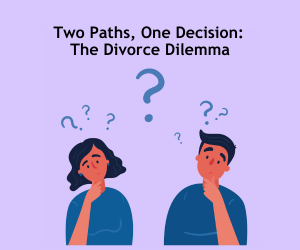 Ask anyone who has ever gone through a divorce whether they have recommendations for how the process could have gone better and I bet they would have a list of ideas. They would likely identify a need for their legal counsel to have communicated more frequently with them and to have helped more to educate them about their options at each step of the process. They would likely say they worried that their legal counsel had a perverse incentive to provide more services (more hours of billable work) seemingly regardless of the effectiveness of those services because they billed by the hour and the client didn’t see or understand much of the work that the attorney was doing.
Many professions, including law and medicine, are rethinking the most basic aspects of the services they provide and how they provide them and are defining new ways of doing things.
I was reminded of this when reading an article in the New York Times titled When Medicine is Futile, which addressed the issue of whether medical providers are sometimes (or even as a matter of standard office policy) over-treating patients during end-of-life medical care.
The article brought up the issue of whether medical providers—in the name of patient protection and patient care—may actually be working against the patient’s best interests (even affirmatively harming patients) by administering an inappropriately excessive—and futile—list of medical interventions.
The article references a new report by the Institute of Medicine titled Dying in America: Improving Quality and Honoring Individual Preferences Near the End of Life (2014). Some of the recommendations for improved care include increased provider-patient communication, education of medical providers in alternatives such as palliative care, increased patient planning and decision making, and different payment structures that may better align with patient care quality more than just the quantity of the services provided. The gist of the recommendations to improve patient care relate mostly to increased communication, increased education of providers and patients about alternative options, and creating systemic incentives to reward quality patient care over simply providing a high quantity of billable services.
Similar to a hospital emergency room, courtrooms offer intensive and expensive services. In the court system, attorneys rack up immense billable hours based on providing clients with a large quantity of paperwork to submit to the court. In the courtroom, attorney-client communication, client education about their options for resolution and client power to make their own decisions can be lacking.
The legal system, like the medical system, is going through a paradigm shift where legal service providers are rethinking even the most basic aspects of the services they provide and how they provide them and are finding new ways of doing things.
Collaborative Practice providers implement best practices similar to those recommended for the medical profession referenced in the report mentioned above, only in the area of legal representation instead of medical care. In the Collaborative process, there is an increased focus on the quality, rather than just the quantity, of legal services. This change in focus is inherent in the agreement of the clients and attorneys that they will not go to court to resolve their conflict as part of the Collaborative process. In the Collaborative model, clients meet with a team of professionals to share information, learn about alternatives that might not have been considered, and evaluate their options in an open discussion. This provides clients with increased knowledge about their options, increased communication with professionals, and true decision-making authority.
Ask anyone who has ever gone through a divorce whether they have recommendations for how the process could have gone better and I bet they would have a list of ideas. They would likely identify a need for their legal counsel to have communicated more frequently with them and to have helped more to educate them about their options at each step of the process. They would likely say they worried that their legal counsel had a perverse incentive to provide more services (more hours of billable work) seemingly regardless of the effectiveness of those services because they billed by the hour and the client didn’t see or understand much of the work that the attorney was doing.
Many professions, including law and medicine, are rethinking the most basic aspects of the services they provide and how they provide them and are defining new ways of doing things.
I was reminded of this when reading an article in the New York Times titled When Medicine is Futile, which addressed the issue of whether medical providers are sometimes (or even as a matter of standard office policy) over-treating patients during end-of-life medical care.
The article brought up the issue of whether medical providers—in the name of patient protection and patient care—may actually be working against the patient’s best interests (even affirmatively harming patients) by administering an inappropriately excessive—and futile—list of medical interventions.
The article references a new report by the Institute of Medicine titled Dying in America: Improving Quality and Honoring Individual Preferences Near the End of Life (2014). Some of the recommendations for improved care include increased provider-patient communication, education of medical providers in alternatives such as palliative care, increased patient planning and decision making, and different payment structures that may better align with patient care quality more than just the quantity of the services provided. The gist of the recommendations to improve patient care relate mostly to increased communication, increased education of providers and patients about alternative options, and creating systemic incentives to reward quality patient care over simply providing a high quantity of billable services.
Similar to a hospital emergency room, courtrooms offer intensive and expensive services. In the court system, attorneys rack up immense billable hours based on providing clients with a large quantity of paperwork to submit to the court. In the courtroom, attorney-client communication, client education about their options for resolution and client power to make their own decisions can be lacking.
The legal system, like the medical system, is going through a paradigm shift where legal service providers are rethinking even the most basic aspects of the services they provide and how they provide them and are finding new ways of doing things.
Collaborative Practice providers implement best practices similar to those recommended for the medical profession referenced in the report mentioned above, only in the area of legal representation instead of medical care. In the Collaborative process, there is an increased focus on the quality, rather than just the quantity, of legal services. This change in focus is inherent in the agreement of the clients and attorneys that they will not go to court to resolve their conflict as part of the Collaborative process. In the Collaborative model, clients meet with a team of professionals to share information, learn about alternatives that might not have been considered, and evaluate their options in an open discussion. This provides clients with increased knowledge about their options, increased communication with professionals, and true decision-making authority.
Two Paths, One Decision: The Divorce Dilemma
Emily and Daniel were in love. Their love story had once been the envy of the neighborhood—a whirlwind romance that blossomed into a marriage filled with laughter, shared dreams, and whispered secrets. But as the years went by, cracks appeared in their fairy tale....



